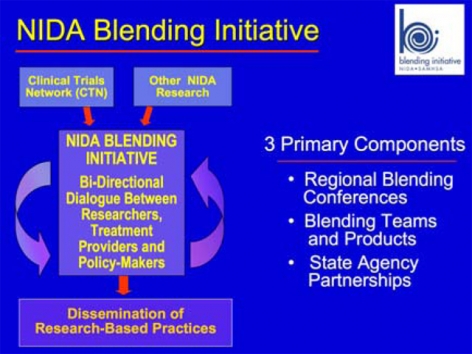Topics in Brief: NIDA's Blending Initiative: Accelerating Research-Based Treatments into Practice
Revised October 2007
Bridging the Gap Between Research and Practice
Thousands of individuals seeking treatment for drug abuse will benefit from the NIDA Blending Initiative, which is designed to accelerate scientific findings into clinical practice. As the leading NIH Institute studying addiction, NIDA's commitment to bridging the gap between research and practice has resulted in the development of innovative tools to put directly in the hands of front-line treatment providers at nearly the same time that research results are published in peer-reviewed journals.
The NIDA Blending Initiative
This Initiative was created in response to the Institute of Medicine's report (1998, 2003) which noted the 17-year gap between the publication of research and its impact on treatment delivery. In 1999 when NIDA launched the National Drug Abuse Treatment Clinical Trials Network (CTN), the Institute harnessed approximately 200 community treatment programs within the CTN to test research-based treatments using the gold standard of clinical research– the randomized clinical trial– in real world settings. As soon as CTN research studies are tested and completed, the results are disseminated through the Blending Initiative, which is composed of three components: Regional Blending Conferences, Blending Products and State Agency Partnerships. The key hallmark of the Blending Initiative is the promotion of bi-directional and productive communication between researchers, treatment providers and policy-makers while also delivering pioneering research findings to the field.
Regional Blending Conferences
In 2000, NIDA launched its "Blending" conference series, "Blending Clinical Practice and Research: Forging Partnerships to Enhance Drug Addiction Treatment Research." Six Blending Conferences have been strategically convened in different geographic regions of the country. All conference sessions are designed to enhance the bi-directional dialogue between researchers, clinical practitioners and policy-makers.
Blending Teams and Products
In 2002, NIDA initiated a historic partnership with the Center for Substance Abuse Treatment (CSAT), Substance Abuse and Mental Health Services Administration (SAMHSA) to expedite the dissemination of NIDA's research results into the addiction treatment field. Blending Teams, composed of NIDA researchers, community treatment providers and trainers from SAMHSA's Addiction Technology Transfer Centers (ATTC) work closely together to create innovative Blending products. Based on recently tested NIDA research, the Blending Teams design userfriendly products for clinical practitioners to use during treatment. Completed products include training packages composed of informational manuals, PowerPoint presentations, videos, CDs, curricula and annotated bibliographies. NIDA co-funds the ATTCs ($1.5 million per year) to support the development of these Blending products.
Since Blending products are developed to fill the specific training needs of the practice community, each product has a specific focus. To date, the following five Blending Products have been developed at nearly the same time that the research results are published in peer-reviewed journals, substantially reducing the gap between research and practice. These include:
- Buprenorphine Treatment: Training for Multidisciplinary Addiction Professionals – The primary goal of this product is to introduce buprenorphine to the addiction field. Buprenorphine is the first addiction treatment medicine to be available in the privacy of a doctor's office.
- Short-Term Opioid Withdrawal Using Buprenorphine – The primary goal of this product is to instruct providers on the administration of a 13-day buprenorphine taper for opioid dependent patients.
- Treatment Planning M.A.T.R.S. – This product instructs providers on how to transform required "paperwork" (assessments, forms, case notes, etc.) into useful clinical information.
- Motivational Interviewing Assessment: Supervisory Tools for Enhancing Proficiency (MIA:STEP) – This product is designed to enhance the effectiveness of motivational interviewing, a technique designed to strengthen a person's commitment to change behavior through treatment.
- Promoting Awareness of Motivational Incentives (PAMI) – These tools provide information about the science-based therapeutic intervention known as Motivational Incentives (MI) and highlights data on how the use of positive reinforcement has reduced drug abuse and has enhanced client retention in treatment programs.
These new Blending products and other information on the NIDA Blending Initiative can be found here.
State Substance Abuse Agencies: Key Partners to Implementing Research-based Practices
The Single State Authorities (SSAs), responsible for managing each State's publicly funded substance abuse system, are interested in the latest treatment research, especially interventions that can improve effectiveness and cost- efficiency. NIDA works closely with multiple national organizations including the National Association of State Alcohol and Drug Abuse Directors (NASADAD) to help identify strategies to accelerate the adoption of evidence-based practices into State drug abuse prevention and treatment programs. To help support these efforts, NIDA awarded several infrastructure grants to States in 2005. These grants ($2.7 million per year for 3 years) promote the implementation of science-based practices across State-wide systems, conduct research to determine the effective components of services delivery, and increase State research capacity.
Strengthening the Bridge
The bi-directional model inherent throughout all levels of the NIDA Blending Initiative is designed to accelerate individual, program and systems-level change across the country. Through Blending, NIDA is able to directly address the challenge of bridging the science of drug abuse and addiction to drug abuse treatment. By combining information, resources and talent from the laboratory, community, and the field, the Blending Initiative will play a critical role in increasing the adoption of research based programs and, therefore, contribute to closing the gap between research and treatment of drug abuse and addiction.



